| dc.contributor.author | Dunse, Thorben | |
| dc.contributor.author | Dong, Kaixing | |
| dc.contributor.author | Aas, Kjetil Schanke | |
| dc.contributor.author | Stige, Leif Christian | |
| dc.coverage.spatial | Svalbard | en_US |
| dc.date.accessioned | 2022-09-09T11:33:27Z | |
| dc.date.available | 2022-09-09T11:33:27Z | |
| dc.date.created | 2022-01-29T06:49:16Z | |
| dc.date.issued | 2022 | |
| dc.identifier.citation | Dunse, T., Dong, K., Aas, K. S., & Stige, L. C. (2022). Regional-scale phytoplankton dynamics and their association with glacier meltwater runoff in Svalbard. Biogeosciences, 19(2), 271-294. | en_US |
| dc.identifier.issn | 1726-4170 | |
| dc.identifier.uri | https://hdl.handle.net/11250/3016889 | |
| dc.description.abstract | Arctic amplification of global warming has accelerated mass loss of Arctic land ice over the past decades and led to increased freshwater discharge into glacier fjords and adjacent seas. Glacier freshwater discharge is typically associated with high sediment load which limits the euphotic depth but may also aid to provide surface waters with essential nutrients, thus having counteracting effects on marine productivity. In situ observations from a few measured fjords across the Arctic indicate that glacier fjords dominated by marine-terminating glaciers are typically more productive than those with only land-terminating glaciers. Here we combine chlorophyll a from satellite ocean color, an indicator of phytoplankton biomass, with glacier meltwater runoff from climatic mass-balance modeling to establish a statistical model of summertime phytoplankton dynamics in Svalbard (mid-June to September). Statistical analysis reveals significant and positive spatiotemporal associations of chlorophyll a with glacier runoff for 7 out of 14 primary hydrological regions but only within 10 km distance from the shore. These seven regions consist predominantly of the major fjord systems of Svalbard. The adjacent land areas are characterized by a wide range of total glacier coverage (35.5%to 81.2 %) and fraction of marine-terminating glacier area (40.2% to 87.4 %). We find that an increase in specific glacier-runoff rate of 10mm water equivalent per 8 d period raises summertime chlorophyll a concentrations by 5.2% to 20.0%, depending on the region. During the annual peak discharge we estimate that glacier runoff increases chlorophyll a by 13.1% to 50.2% compared to situations with no runoff. This suggests that glacier runoff is an important factor sustaining summertime phytoplankton production in Svalbard fjords, in line with findings from several fjords in Greenland. In contrast, for regions bordering open coasts, and beyond 10 km distance from the shore, we do not find significant associations of chlorophyll a with runoff. In these regions, physical ocean and sea-ice variables control chlorophyll a, pointing at the importance of a late sea-ice breakup in northern Svalbard, as well as the advection of Atlantic water masses along the West Spitsbergen Current for summertime phytoplankton dynamics. Our method allows for the investigation and monitoring of glacier-runoff effects on primary production throughout the summer season and is applicable on a pan-Arctic scale, thus complementing valuable but scarce in situ measurements in both space and time. | en_US |
| dc.language.iso | eng | en_US |
| dc.publisher | European Geosciences Union | en_US |
| dc.rights | Navngivelse 4.0 Internasjonal | * |
| dc.rights.uri | http://creativecommons.org/licenses/by/4.0/deed.no | * |
| dc.title | Regional-scale phytoplankton dynamics and their association with glacier meltwater runoff in Svalbard | en_US |
| dc.type | Peer reviewed | en_US |
| dc.type | Journal article | en_US |
| dc.description.version | publishedVersion | en_US |
| dc.rights.holder | © The Author(s) 2022 | en_US |
| dc.source.pagenumber | 271-294 | en_US |
| dc.source.volume | 19 | en_US |
| dc.source.journal | Biogeosciences | en_US |
| dc.source.issue | 2 | en_US |
| dc.identifier.doi | 10.5194/bg-19-271-2022 | |
| dc.identifier.cristin | 1993044 | |
| cristin.ispublished | true | |
| cristin.fulltext | original | |
| cristin.qualitycode | 1 | |

